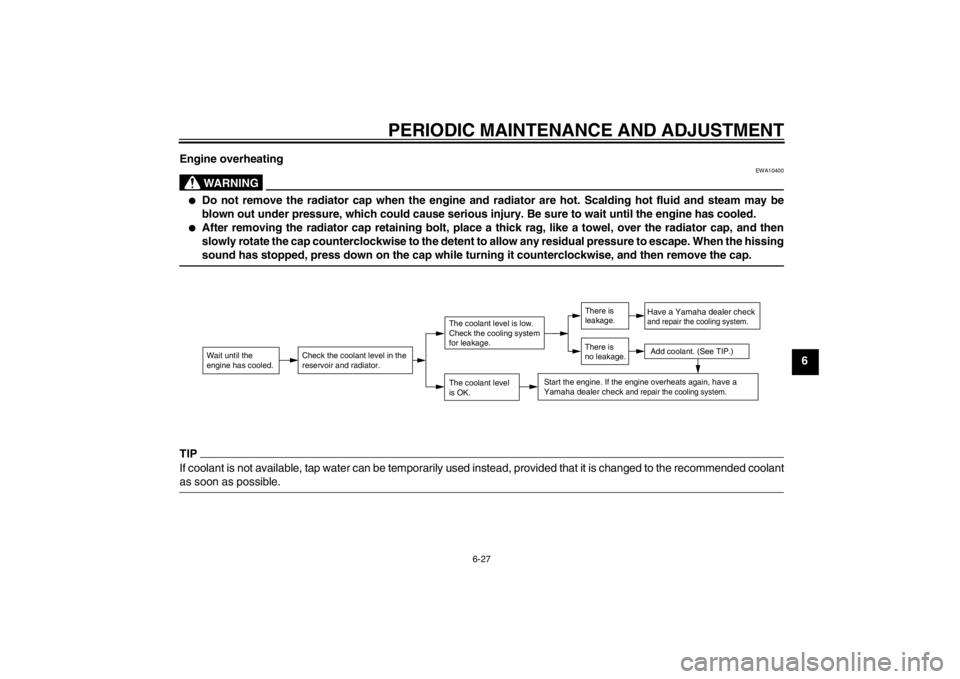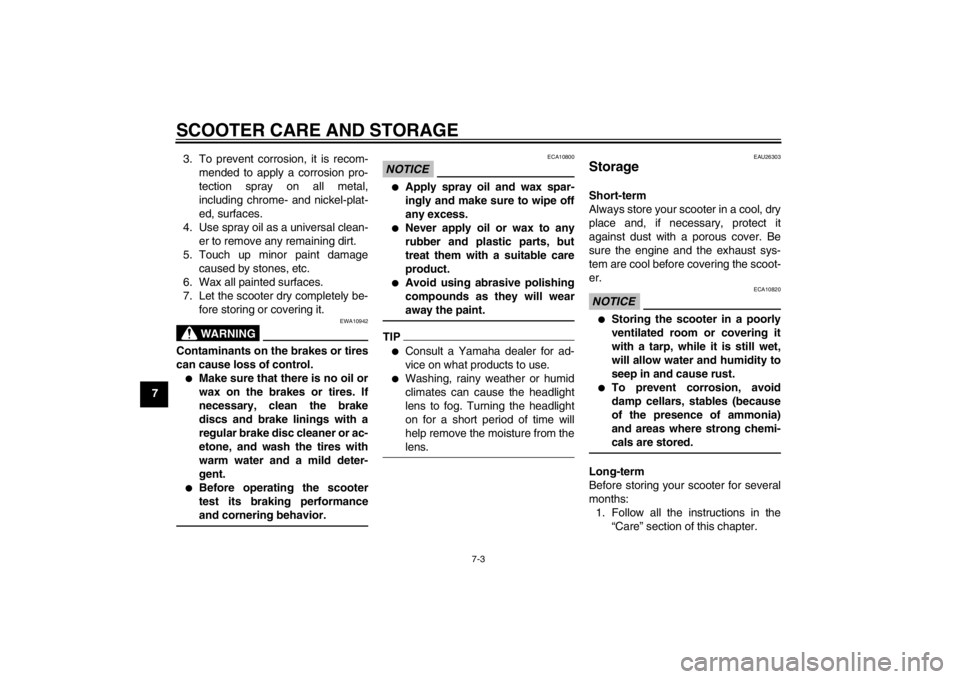2013 YAMAHA AEROX50 warning
[x] Cancel search: warningPage 61 of 74

PERIODIC MAINTENANCE AND ADJUSTMENT
6-25
6 5. Insert a new bulb into the socket.
6. Install the socket (together with the
bulb) by pushing it in.
7. Install the cowling.
EAU25881
Troubleshooting Although Yamaha scooters receive a
thorough inspection before shipment
from the factory, trouble may occur dur-
ing operation. Any problem in the fuel,
compression, or ignition systems, for
example, can cause poor starting and
loss of power.
The following troubleshooting charts
represent quick and easy procedures
for checking these vital systems your-
self. However, should your scooter re-
quire any repair, take it to a Yamaha
dealer, whose skilled technicians have
the necessary tools, experience, and
know-how to service the scooter prop-
erly.
Use only genuine Yamaha replace-
ment parts. Imitation parts may look like
Yamaha parts, but they are often inferi-
or, have a shorter service life and can
lead to expensive repair bills.
WARNING
EWA15141
When checking the fuel system, do
not smoke, and make sure there are
no open flames or sparks in the ar-
ea, including pilot lights from waterheaters or furnaces. Gasoline or
gasoline vapors can ignite or ex-
plode, causing severe injury or
property damage.
1. Auxiliary light bulb
U1PHE0E0.book Page 25 Wednesday, August 29, 2012 4:42 PM
Page 63 of 74

PERIODIC MAINTENANCE AND ADJUSTMENT
6-27
6 Engine overheating
WARNING
EWA10400
●
Do not remove the radiator cap when the engine and radiator are hot. Scalding hot fluid and steam may be
blown out under pressure, which could cause serious injury. Be sure to wait until the engine has cooled.
●
After removing the radiator cap retaining bolt, place a thick rag, like a towel, over the radiator cap, and then
slowly rotate the cap counterclockwise to the detent to allow any residual pressure to escape. When the hissing
sound has stopped, press down on the cap while turning it counterclockwise, and then remove the cap.
TIPIf coolant is not available, tap water can be temporarily used instead, provided that it is changed to the recommended coolant
as soon as possible.
Wait until the
engine has cooled.
Check the coolant level in the
reservoir and radiator.
The coolant level
is OK.The coolant level is low.
Check the cooling system
for leakage.
Have a Yamaha dealer checkand repair the cooling system.Add coolant. (See TIP.)
Start the engine. If the engine overheats again,
have a
Yamaha dealer check
and repair the cooling system.
There is
leakage.
There is
no leakage.
U1PHE0E0.book Page 27 Wednesday, August 29, 2012 4:42 PM
Page 66 of 74

SCOOTER CARE AND STORAGE
7-3
73. To prevent corrosion, it is recom-
mended to apply a corrosion pro-
tection spray on all metal,
including chrome- and nickel-plat-
ed, surfaces.
4. Use spray oil as a universal clean-
er to remove any remaining dirt.
5. Touch up minor paint damage
caused by stones, etc.
6. Wax all painted surfaces.
7. Let the scooter dry completely be-
fore storing or covering it.
WARNING
EWA10942
Contaminants on the brakes or tires
can cause loss of control.●
Make sure that there is no oil or
wax on the brakes or tires. If
necessary, clean the brake
discs and brake linings with a
regular brake disc cleaner or ac-
etone, and wash the tires with
warm water and a mild deter-
gent.
●
Before operating the scooter
test its braking performance
and cornering behavior.
NOTICE
ECA10800
●
Apply spray oil and wax spar-
ingly and make sure to wipe off
any excess.
●
Never apply oil or wax to any
rubber and plastic parts, but
treat them with a suitable care
product.
●
Avoid using abrasive polishing
compounds as they will wear
away the paint.
TIP●
Consult a Yamaha dealer for ad-
vice on what products to use.
●
Washing, rainy weather or humid
climates can cause the headlight
lens to fog. Turning the headlight
on for a short period of time will
help remove the moisture from the
lens.
EAU26303
Storage Short-term
Always store your scooter in a cool, dry
place and, if necessary, protect it
against dust with a porous cover. Be
sure the engine and the exhaust sys-
tem are cool before covering the scoot-
er.NOTICE
ECA10820
●
Storing the scooter in a poorly
ventilated room or covering it
with a tarp, while it is still wet,
will allow water and humidity to
seep in and cause rust.
●
To prevent corrosion, avoid
damp cellars, stables (because
of the presence of ammonia)
and areas where strong chemi-
cals are stored.
Long-term
Before storing your scooter for several
months:
1. Follow all the instructions in the
“Care” section of this chapter.
U1PHE0E0.book Page 3 Wednesday, August 29, 2012 4:42 PM
Page 67 of 74

SCOOTER CARE AND STORAGE
7-4
7 2. Drain the carburetor float chamber
by loosening the drain bolt; this will
prevent fuel deposits from building
up. Pour the drained fuel into the
fuel tank.
3. Fill up the fuel tank and add fuel
stabilizer (if available) to prevent
the fuel tank from rusting and the
fuel from deteriorating.
4. Perform the following steps to pro-
tect the cylinder, piston rings, etc.
from corrosion.
a. Remove the spark plug cap
and spark plug.
b. Pour a teaspoonful of engine oil
into the spark plug bore.
c. Install the spark plug cap onto
the spark plug, and then place
the spark plug on the cylinder
head so that the electrodes are
grounded. (This will limit spark-
ing during the next step.)
d. Turn the engine over several
times with the starter. (This will
coat the cylinder wall with oil.)
WARNING! To prevent dam-
age or injury from sparking,
make sure to ground thespark plug electrodes while
turning the engine over.
[EWA10951]
e. Remove the spark plug cap
from the spark plug, and then
install the spark plug and the
spark plug cap.
5. Lubricate all control cables and the
pivoting points of all levers and
pedals as well as of the side-
stand/centerstand.
6. Check and, if necessary, correct
the tire air pressure, and then lift
the scooter so that both of its
wheels are off the ground. Alterna-
tively, turn the wheels a little every
month in order to prevent the tires
from becoming degraded in one
spot.
7. Cover the muffler outlet with a
plastic bag to prevent moisture
from entering it.
8. Remove the battery and fully
charge it. Store it in a cool, dry
place and charge it once a month.
Do not store the battery in an ex-
cessively cold or warm place [less
than 0 °C (30 °F) or more than 30°C (90 °F)]. For more information
on storing the battery, see page
6-19.
TIPMake any necessary repairs before
storing the scooter.
U1PHE0E0.book Page 4 Wednesday, August 29, 2012 4:42 PM
Page 70 of 74

SPECIFICATIONS
8-3
8
High beam indicator light:
LED
Oil level warning light:
LED
Turn signal indicator light:
LED
Fuel level warning light:
LED
Coolant temperature warning light:
LEDFuses:Main fuse:
7.5 A
U1PHE0E0.book Page 3 Wednesday, August 29, 2012 4:42 PM
Page 72 of 74

INDEX22-stroke engine oil................................. 3-10AAcceleration and deceleration................. 5-2
Air filter element, cleaning..................... 6-10
Auxiliary light bulb, replacing
(if equipped)........................................ 6-24BBattery................................................... 6-19
Brake fluid, changing ............................ 6-16
Brake fluid level, checking .................... 6-15
Brake lever, front..................................... 3-7
Brake lever, rear ..................................... 3-7
Brake levers, lubricating........................ 6-17
Braking .................................................... 5-2CCarburetor,adjusting ............................. 6-11
Care ........................................................ 7-1
Catalytic converter ................................ 3-10
Centerstand, checking and
lubricating ........................................... 6-17
Coolant.................................................... 6-9
Coolant temperature warning light .......... 3-3
Cowling and panel, removing and
installing................................................ 6-6DDimmer switch ........................................ 3-7EEngine break-in ....................................... 5-3FFinal transmission oil .............................. 6-8
Front and rear brake lever free play,
checking ............................................. 6-14
Front and rear brake pads, checking .... 6-15Front fork, checking .............................. 6-18
Fuel......................................................... 3-9
Fuel and 2-stroke engine oil tank caps ... 3-8
Fuel consumption, tips for reducing........ 5-3
Fuel level warning light ........................... 3-3
Fuse, replacing ..................................... 6-21
HHandlebar switches ................................ 3-6
Headlight bulb, replacing ...................... 6-22
High beam indicator light ........................ 3-2
Horn switch ............................................. 3-7IIdentification numbers ............................ 9-1
Indicator lights and warning light ............ 3-2KKickstarter............................................. 3-11LLicense plate light ................................. 6-24MMain switch/steering lock........................ 3-1
Maintenance and lubrication, periodic .... 6-3
Maintenance, emission control
system .................................................. 6-2
Matte color, caution ................................ 7-1
Model label ............................................. 9-1
Multi-function display (NS50).................. 3-4OOil level warning light.............................. 3-2PParking ................................................... 5-4
Part locations .......................................... 2-1SSafe-riding points.................................... 1-5
Safety information................................... 1-1Seats ..................................................... 3-11
Shock absorber assembly,
adjusting (if equipped) ........................ 3-13
Spark plug, checking ............................... 6-7
Specifications .......................................... 8-1
Speedometer unit (NS50N) ..................... 3-3
Starting a cold engine ............................. 5-1
Starting off ............................................... 5-2
Start switch.............................................. 3-7
Steering, checking................................. 6-19
Storage.................................................... 7-3
Storage compartment............................ 3-12
TTail/brake light bulb, replacing .............. 6-23
Throttle grip and cable, checking and
lubricating ........................................... 6-17
Throttle grip free play, checking ............ 6-11
Tires ...................................................... 6-12
Troubleshooting .................................... 6-25
Troubleshooting charts.......................... 6-26
Turn signal indicator light ........................ 3-2
Turn signal light bulb, replacing ............ 6-23
Turn signal switch ................................... 3-7VVehicle identification number .................. 9-1WWheel bearings, checking ..................... 6-19
Wheels .................................................. 6-14
U1PHE0E0.book Page 1 Wednesday, August 29, 2012 4:42 PM